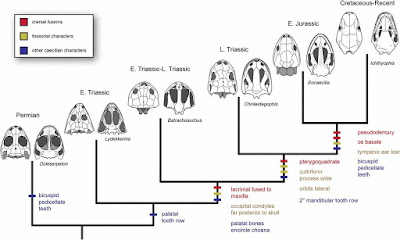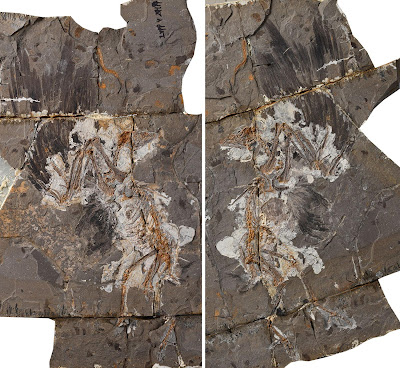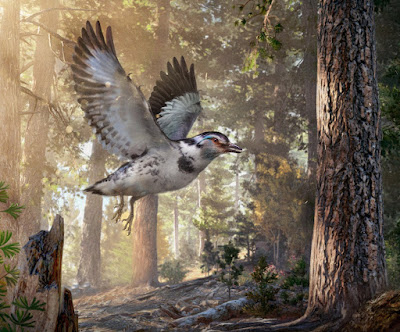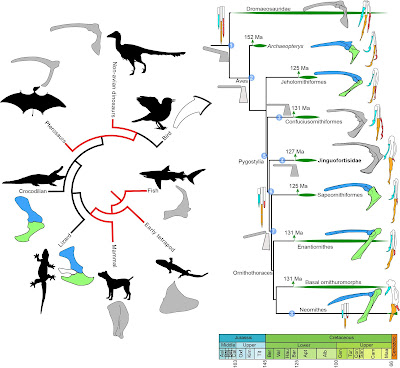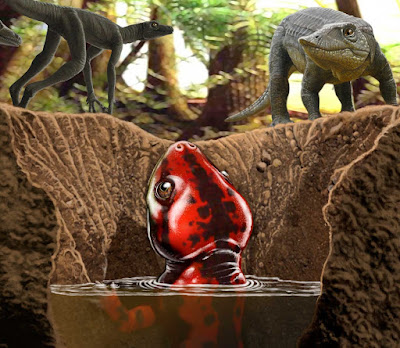 |
| Chinlestegophis jenkinsi Pardo, Small & Huttenlocker, 2017 |
Significance:
Research into modern amphibian origins is increasingly focusing on the limbless caecilians, a poorly studied group whose pre-Cenozoic fossils are limited to two species. We describe tiny fossils from the Triassic of Colorado with a mixture of traits found in caecilians and extinct Permian–Triassic temnospondyls: Stereospondyli. Computed 3D tomography shows how skull bones organized around internal structures, and we suggest how these may have become fused or simplified in caecilians. The fossils’ association with burrows highlights ecological diversity of Triassic amphibians as well as when and how burrowing evolved in the stereospondyl ancestors of caecilians. Our narrative for research on amphibian origins highlights the importance of stereospondyls, the most numerous and anatomically diverse amphibian group of the Triassic.
Abstract
The origin of the limbless caecilians remains a lasting question in vertebrate evolution. Molecular phylogenies and morphology support that caecilians are the sister taxon of batrachians (frogs and salamanders), from which they diverged no later than the early Permian. Although recent efforts have discovered new, early members of the batrachian lineage, the record of pre-Cretaceous caecilians is limited to a single species, Eocaecilia micropodia. The position of Eocaecilia within tetrapod phylogeny is controversial, as it already acquired the specialized morphology that characterizes modern caecilians by the Jurassic. Here, we report on a small amphibian from the Upper Triassic of Colorado, United States, with a mélange of caecilian synapomorphies and general lissamphibian plesiomorphies. We evaluated its relationships by designing an inclusive phylogenetic analysis that broadly incorporates definitive members of the modern lissamphibian orders and a diversity of extinct temnospondyl amphibians, including stereospondyls. Our results place the taxon confidently within lissamphibians but demonstrate that the diversity of Permian and Triassic stereospondyls also falls within this group. This hypothesis of caecilian origins closes a substantial morphologic and temporal gap and explains the appeal of morphology-based polyphyly hypotheses for the origins of Lissamphibia while reconciling molecular support for the group’s monophyly. Stem caecilian morphology reveals a previously unrecognized stepwise acquisition of typical caecilian cranial apomorphies during the Triassic. A major implication is that many Paleozoic total group lissamphibians (i.e., higher temnospondyls, including the stereospondyl subclade) fall within crown Lissamphibia, which must have originated before 315 million years ago.
Keywords: burrow, Gymnophiona, temnospondyl, tetrapod, Triassic
 |
| Chinlestegophis jenkinsi, a tiny subterranean carnivore, is an ancient relative of frogs and salamanders. (Illustration/Jorge Gonzalez) |
Tetrapoda Haworth, 1825
Temnospondyli Zittel, 1888
Stereospondyli Zittel, 1887
Chinlestegophis jenkinsi gen. et sp. nov.
Etymology. Jenkins’s amphibian-serpent from the Chinle.
“Chinle” for the Triassic Chinle Formation; “stego-” (Greek) meaning cover or roof, but commonly applied to temnospondyl amphibians and other early tetrapods; “-ophis” (Greek) meaning serpent. The species name honors paleontologist Farish Jenkins, whose work on the Jurassic Eocaecilia inspired the present study.
“Chinle” for the Triassic Chinle Formation; “stego-” (Greek) meaning cover or roof, but commonly applied to temnospondyl amphibians and other early tetrapods; “-ophis” (Greek) meaning serpent. The species name honors paleontologist Farish Jenkins, whose work on the Jurassic Eocaecilia inspired the present study.
Jason D. Pardo, Bryan J. Small and Adam K. Huttenlocker. 2017. Stem Caecilian from the Triassic of Colorado Sheds Light On the Origins of Lissamphibia. Proceedings of the National Academy of Sciences of the United States of America. in press. DOI: 10.1073/pnas.1706752114
Tiny fossils reveal backstory of the most mysterious amphibian alive today
The discovery fills a significant gap in the evolutionary history of frogs, toads and other amphibians
---------------------------------------------------------------
روابط التحميل والمشاهدة، الروابط المباشرة للتحميل
او
شاهد هذا الفيديو القصير لطريقة التحميل البسيطة
كيف تحصل على مدونة جاهزة بآلاف المواضيع والمشاركات من هنا
شاهد قناة منتدى مدونات بلوجر جاهزة بألاف المواضيع والمشاركات على اليوتيوب لمزيد من الشرح من هنا
رابط مدونة منتدى مدونات بلوجر جاهزة بآلاف المواضيع والمشاركات في أي وقت حــــتى لو تم حذفها من هنا
شاهد صفحة منتدى مدونات بلوجر جاهزة بألاف المواضيع والمشاركات على الفيس بوك لمزيد من الشرح من هنا
شاهد صفحة منتدى مدونات بلوجر جاهزة بألاف المواضيع والمشاركات على الفيس بوك لمزيد من الشرح من هنا
تعرف على ترتيب مواضيع منتدى مدونات بلوجر جاهزة بآلاف المواضيع والمشاركات (حتى لا تختلط عليك الامور) من هنا
ملاحظة هامة: كل عمليات تنزيل، رفع، وتعديل المواضيع الجاهزة تتم بطريقة آلية، ونعتذر عن اي موضوع مخالف او مخل بالحياء مرفوع بالمدونات الجاهزة بآلاف المواضيع والمشاركات، ولكم ان تقوموا بحذف هذه المواضيع والمشاركات والطريقة بسيطة وسهلة. ــــــــــــــــــــــــــــــــــــــــــــــــــــــــــــــــــــــــــــــسلامـ.



